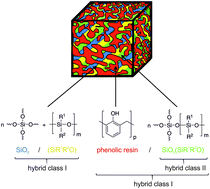Ternary organic–inorganic nanostructured hybrid materials by simultaneous twin polymerization†
Abstract
The acid and base catalyzed simultaneous twin polymerization (STP) of various 2,2′-disubstituted 4H-1,3,2-benzodioxasiline derivatives 2a–d with 2,2′-spirobi[4H-1,3,2-benzodioxasiline] (1) are presented in this paper. The products are nanostructured ternary organic–inorganic hybrid materials consisting of a cross-linked organic polymer, silica and a disubstituted polysiloxane. It can be demonstrated whether and in which extent the copolymerization of the two inorganic fragments of 1 and 2 takes place among the STP and how the molar ratio of the two components determines the structure formation of the resulting hybrid material. Steric and electronic effects of the substituents at the silicon center of 2 on the molecular structure formation and the morphology of the resulting hybrid material were investigated by means of solid state CP MAS 29Si and 13C NMR spectroscopy as well as high-angle annular dark-field scanning transmission electron microscopy (HAADF-STEM). The mechanical properties (hardness and Young's modulus) of the hybrid materials were analyzed by means of nanoindentation measurements.


 Please wait while we load your content...
Please wait while we load your content...